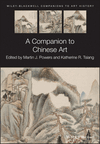Ornament in China
Jessica Rawson
Search for more papers by this authorJessica Rawson
Search for more papers by this authorMartin J. Powers
Search for more papers by this authorKatherine R. Tsiang
Search for more papers by this authorSummary
Correlation of artifacts' decorative qualities (including motifs, and colors) with social structures is one of the abiding features of China's ornamental traditions. This chapter discusses Chinese ornament within three relatively large time frames: (1) early China; (2) the early empires and their successors; (3) the period of the dynasties of the Song to Qing periods. In the early period, the earliest functions of ornament were to decorate ceramics, a material representative of China and one that has a very strong foundation in the region's history. While many motifs on gold had a very short life as a court fashion during the period of the early empires, one important ornamental and long-lasting contribution was the cloud scroll. Under the Song, two approaches dominated and affected ornament: a concern for moderation and decorum and a return to the past. Qing emperors oversaw the creation of palace complexes adorned with Chinese auspicious ornament.
References Further Reading
- Bagley , R. ( 1987 ). Shang Ritual Bronzes in the Arthur M. Sackler Collections. Washington, DC : Arthur M. Sackler Foundation .
- Barbieri-Low , A. ( 2007 ). Artisans in Early Imperial China . Seattle : University of Washington Press .
- Bartholomew , T. ( 2006 ). Hidden Meanings in Chinese Art . San Francisco : Asian Art Museum—Chong-Moon Lee Centre for Asian Art and Culture .
-
Bickford , M.
(
2002
).
Emperor Huizong and the Aesthetics of Agency
.
Archives of Asian Art
,
53
:
71
–
104
.
10.1484/aaa.2003.0005 Google Scholar
- Ch'en Fang-mei ( 2000 ). The Three Dynasties Revisited: Sung Imitations of Ancient Bronzes in the National Palace Museum . In National Palace Museum (ed.), China at the Inception of the Second Millennium, Art and Culture of the Sung Dynasty (960–1279) . Taipei : National Palace Museum , pp. 293 – 320 .
-
Clunas , C.
(
1991
).
Superfluous Things: Material Culture and Social Status in Early Modern China
.
Cambridge
:
Polity Press
.
10.1515/9780824841300 Google Scholar
- Gombrich , E. ( 1979 ). The Sense of Order: A Study in the Psychology of the Decorative Arts. Oxford : Phaidon Press .
- Gruber , A. (ed.) ( 1996 ). The History of Decorative Arts, Classicism and the Baroque in Europe . New York : Abbeville Press .
- Hay , J. ( 2010 ). Sensuous Surfaces, the Decorative Object in Early Modern China . London : Reaktion Press .
- Jacobson , E. ( 1985 ). A Reconsideration of the Origins of Chinese Landscape Representation . Bulletin of the Museum of Far Eastern Antiquities , 57 : 133 – 180 .
- Kuhn , D. (ed.) ( 2012 ). The Culture and Civilization of China: Chinese Silks . New Haven, CT : Yale University Press .
- Ledderose , L. ( 2000 ). Ten Thousand Things—Module and Mass Production in Chinese Art . Princeton, NJ : Princeton University Press .
- Li Zhiyan , Bower , V. , and He , Li ( 2010 ). Chinese Ceramics from the Paleolithic Period through the Qing Dynasty . New Haven, CT : Yale University Press .
- Lin , J. (ed.) ( 2012 ). The Search for Immortality, Tomb Treasures of Han China . New Haven, CT : Yale University Press .
- Loehr , M. ( 1967 ). The Fate of Ornament in Chinese Art . Archives of Asian Art , 21 : 8 – 19 .
- Mizuno , S. and Nagahiro , T. ( 1952 –1956). Yün-kang, The Buddhist Cave Temples of the Fifth Century ad in North China , 16 vols. Kyoto : Kyoto University .
- Piggott , S. ( 1992 ). Wagon, Chariot and Carriage, Symbol and Status in the History of Transport. London : Thames and Hudson .
- Powers , M. ( 1991 ). Art and Political Expression in Early China . New Haven, CT: Yale University Press .
- Powers , M. ( 2006 ). Pattern and Person, Ornament, Society, and Self in Classical China . Cambridge, MA : Harvard University Press .
- Rawski , E. and Rawson , J. (eds.) ( 2005 ). China: The Three Emperors, 1662–1795 . London : Royal Academy of Arts .
- Rawson , J. ( 1984 ). Chinese Ornament, the Lotus and the Dragon . London : British Museum Publications for the Trustees of the British Museum .
- Riegl , A. ( 1992 ). Problems of Style, Foundations for a History of Ornament , trans. E. Kain, annot. and intro. D. Castriota, preface Henry Zerner. Princeton, NJ : Princeton University Press .
- Roxburgh , D. ( 2005 ). The Persian Album, From Dispersal to Collection . New Haven, CT : Yale University Press .
- Summerson , J. ( 1980 ). The Classical Language of Architecture . London : Thames and Hudson .
- Wan , M. ( 2009 ). Building an Immortal Land: The Ming Jiajing Emperor's West Park . Asia Major , 22 ( 2 ): 65 – 99 .
- Watt , J. , Harper , P. O. , et al. ( 2004 ). China: Dawn of a Golden Age, 200–750 ad. New York : Metropolitan Museum of Art .
- Guojiazhuang ( 1998 ). Zhongguo shehui kexueyuan kaogu yanjiusuo . Anyang Yinxu Guojiazhuang Shang dai muzang . Beijing : Zhongguo da baike quanshu chubanshe .
- Rawson , J. ( 2006 ). Ornament as System: Chinese Bird-and-Flower Design . The Burlington Magazine , 148 : 380 – 389 .



